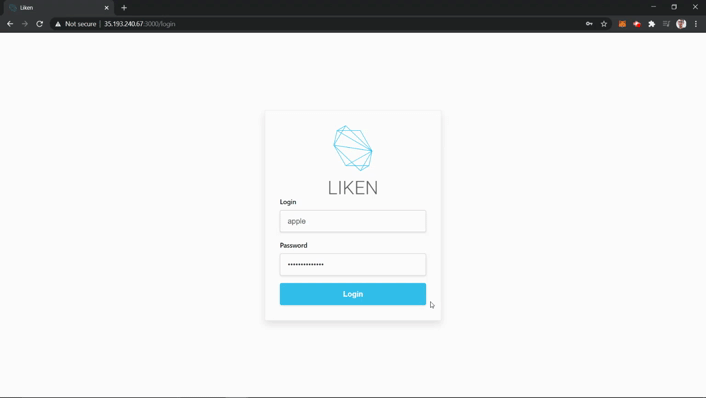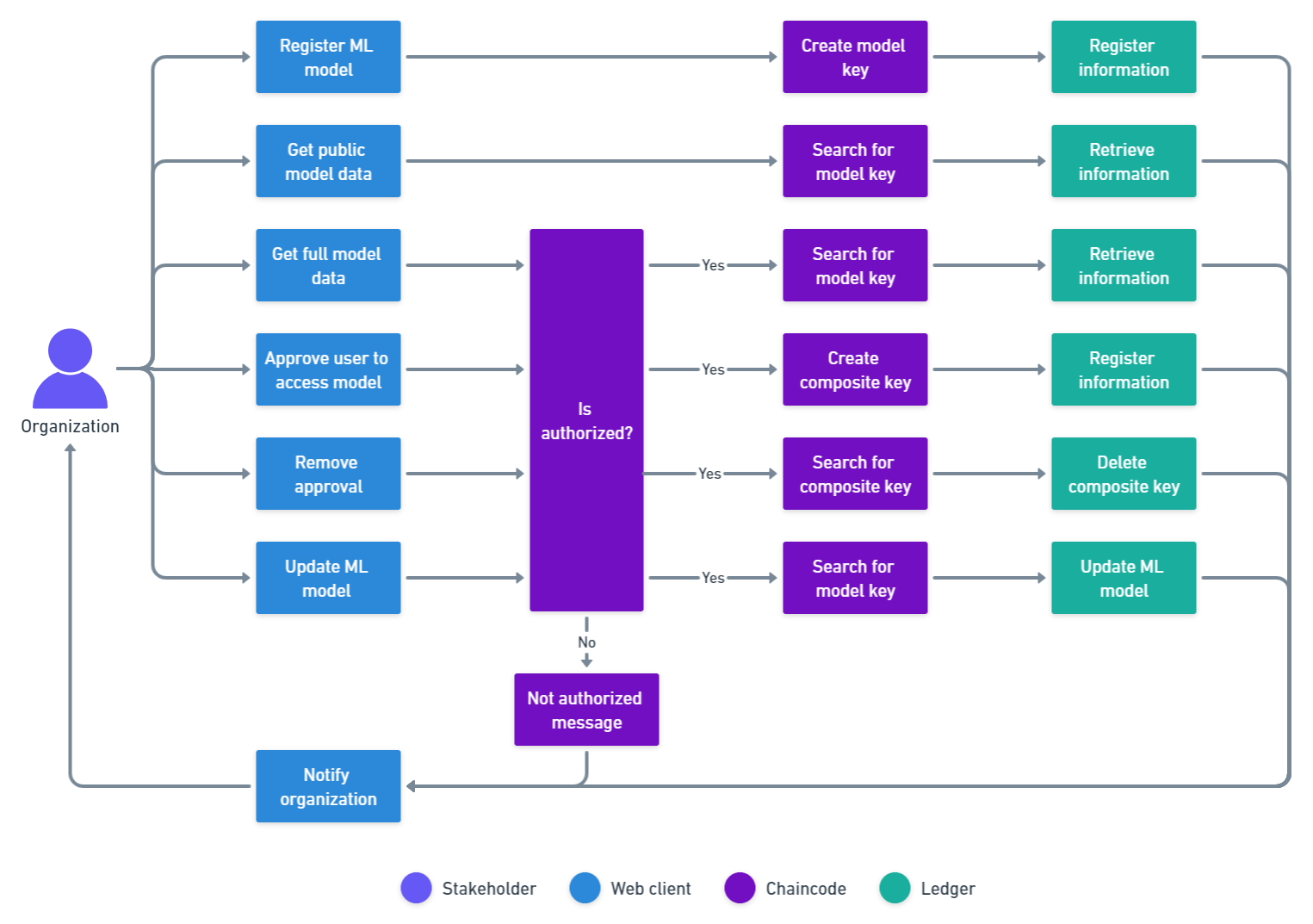Reliable environment for sharing AI models using Hyperledger Fabric

Blockchain solution for sharing AI models among organizations, using Hyperledger Fabric, Node.js and ReactJS. Presented as Capstone Project for the Blockchain Development program from George Brown College.
You can check out the slides used in the final presentation here: Final Presentation.

 Summary
SummaryIn the chart below (source: pcmag) you can see the big data growth along the last years until 2019 and a growth projection for 274 billion dollars in 2022.

In the era where data is the new gold, organizations can have predictive advantages in the market if they have access to the right tools or to the right sources. On one hand we have machine learning and deep learning algorithms, which requires a great amount of data to get better results. On the other hand we have blockchain, which focuses on the most relevant data in order to build a reliable environment.
 Why Liken?
Why Liken? The original word, Lichen, is a mutually beneficial relationship of algae or bacteria and fungi.
The original word, Lichen, is a mutually beneficial relationship of algae or bacteria and fungi.
 Finding Lichen on the trees is a good sign that the environment is healthy and it is ok to breathe that air.
Finding Lichen on the trees is a good sign that the environment is healthy and it is ok to breathe that air.
 Liken will provide a save environment where every organization that joins will benefit sharing their data and AI models under terms and conditions.
Liken will provide a save environment where every organization that joins will benefit sharing their data and AI models under terms and conditions.
 Architecture
ArchitectureThis project combines these two cutting edge technologies. Since huge datasets are stored in data lakes, my intention is to use hyperledger fabric as a means to record only the artificial intelligence models and to control data access among organizations that are interested in these models. The ledger would act as an access management system storing the permission by which a business can access and use the organization’s data.
Once the organizations join the network, their datasets, AI models and sensitive information will be safe. In a collaborative and decentralized network, AI models can find the right datasets to be improved and organizations can find the right AI models to acquire the market advantage.

 Flow Chart
Flow ChartThe following chart represents the flow of this MPV. You can check the flow chart of the full solution here.
Every organization that joins the network will be able to interact with the ledger through the user interface. Both registration of a new model and access to public model data can easily be requested through the interface. However, transactions that can interact with sensitive information from other network participants, such as updating and approval management, requires another level of security. In these cases, both server authentications and chaincode verifications are employed.

 Sequence Diagram
Sequence DiagramThe following diagram represents the flow of this MPV. You can check the full sequence diagram here.

 Timeline
TimelineThis is the timeline implementation and future goals for this project:

 Ledger Information
Ledger Information| Parameter | Type | Description |
|---|---|---|
owner |
string |
Organization who published first and owns the model. |
modelObject |
buffer |
Buffer format of the model file. |
modelName |
string |
Name of the model. |
modelDescription |
string |
Description of the model. |
publicationDate |
Date |
Last time when the model was updated. |
whoPublishedLast |
string |
Who was the organization who last updated the model. |
| Parameter | Type | Description |
|---|---|---|
modelKey |
string |
CouchDB key used to query the model data. |
terms |
buffer |
Terms of the model loan. |
conditions |
string |
Conditions of the model loan. |
expirationDate |
Date |
Deadline by which the borrowing organization can update the model. |
user |
string |
Organization who borrowed the model. |
| Function | Visibility | Parameters | Action | Returns |
|---|---|---|---|---|
initLedger |
public | array of objects initialData |
Populates the ledger with initialData parameter. Can be called only once. | |
registerModel |
public | object modelData |
Stringifies model parameter. Saves the model in the ledger. | bool success or fail |
approve |
public | string modelKey, string user |
Allows users to update models. Creates composite key. | bool success or fail |
remove |
public | string modelKey, string user |
Removes user allowance. Deletes composite key. | bool success or fail |
updateModel |
public | string modelKey, object modelUpdate |
Checks if the caller is allowed to update the model. Update model. | bool success or fail |
queryAllModelsByOwner |
public | Verifies if caller is owner of any registered model. Returns a list of models. | array of objects models |
|
queryAllModelsByApprovedUser |
public | Returns a list of models approved for caller | array of objects models |
|
isOwner |
private | string modelKey |
Verifies if caller is the model owner | bool |
isApproved |
private | string modelKey |
Verifies if user is owner or allowed to update model | bool |
getCallerId |
private | Extracts the CA Id. | string Id |
|
getModelsByCaller |
private | Returns a list of models approved by the caller. | array of objects models |
|
getRelationsArray |
private | Iterator relationsResultIterator |
Iterates a composite key iterator. | array of strings model keys |
 API information
API information| End Point | Method | Params | HLF function | Returns |
|---|---|---|---|---|
\org\index |
GET | - | - | list of organizations |
\org\login |
POST | login; passowrd | - | JWT; credentials |
\org\registerModel |
POST | credentials; name; description; model object | registerModel |
status message; model key |
\org\getModelData |
GET | modelKey; credentials | getModelData |
public model data |
\org\getFullModelData |
GET | modelKey; credentials | getFullModelData |
full model data |
\org\approve |
POST | modelKey; credentials; org; terms | approve |
status message |
\org\remove |
POST | modelKey; credentials; | remove |
status message |
\org\queryAllModelsByOwner |
GET | credentials; | queryAllModelsByOwner |
list of models |
\org\queryAllModelsByApprovedUser |
GET | credentials; | queryAllModelsByApprovedUser |
list of models |
\org\updateModel |
PUT | credentials; name; description; model object | updateModel |
status message |
 How to run
How to runThis project was developed using a Google Cloud Platform virtual machine, so every step must be performed in a VM CLI under a sudo -s command.
Start your VM and save the highlighted External IP:

You must have Fabric samples to run this project. You will clone this project inside fabric-samples folder so as to this can use the files from bin and config folders.
Here you can see the folder structure and the main files mentioned in this section:
📦fabric-samples┣ 📂bin┣ 📂config┗ 📂Liken┣ 📂api┣ 📂chaincode┣ 📂frontend┗ 📂src┗ 📂service┗ 📜baseURL.json┣ 📂test-network┣ 📜.env┣ 📜networkDown.sh┗ 📜setUp.sh
Open your terminal in the fabric-samples folder and clone the project.
# Clone this repogit clone https://github.com/LorranSutter/Liken.git# Go to the project foldercd Liken
To run the application you will need to set your own configurations of port, database, private key and encryption key. Create the following .env file in the indicated path and format with your customized configurations. You can use .env.sample and rename it to .env:
// ./.envPORT_API=5000PRIVATE_KEY="54AD766F231CCB0EA64156F1E5488"ENCRYPTION_KEY="CoCKidLqlVuB8y1EYmKaye1UGoxtHmko1LmyqOHvVht="MONGODB_URI_DEV="YOUR_MONGO_URI"
Now you will need two opened terminals to run the project. One for the API and another one for the frontend.
API will run on http://35.193.245.108:5000/
Frontend will run on http://35.193.245.108:3000/
## In the first terminal ### Go to the chaincode foldercd chaincode# Install dependenciesnpm install# Go to the API applicationcd ../api# Install dependenciesnpm install
## In the second terminal ### Go to the frontend applicationcd frontend# Install dependenciesnpm install
In order to connect frontend to the API, you will have to provide the base URL of the API in the following file:
## In the second terminal ### Go to the baseURL.json filecd src/service/baseURL.json{"baseURL": "http://35.193.245.108:5000"}
Now you can start the network and perform all necessary set up running the following magic script:
## In the first terminal ### Go to the rootcd ..# Run the set up script./setUp.sh
Run the API application:
## In the first terminal ### Go to the API applicationcd api# Run API applicationnpm run start# Or to use nodemonnpm run dev
Finally run the frontend application:
## In the second terminal ### Run the projectnpm start
If you want to stop the network and delete all artifacts created, just run the next magic script below:
## In the first terminal ### Go to the rootcd ..# Run the script./networkDown.sh
Organization
 Resources and Tools
Resources and Tools 
 Technologies
TechnologiesHyperledger
Backend
Frontend
 Credits
Credits